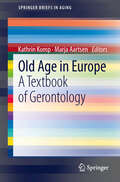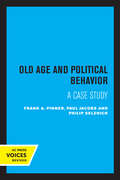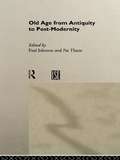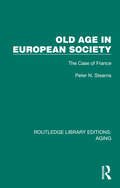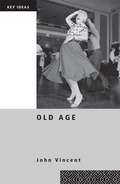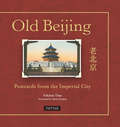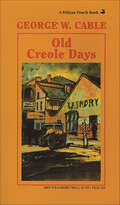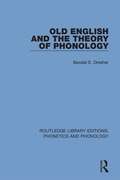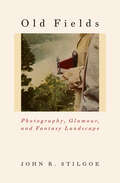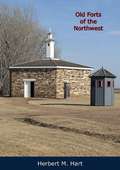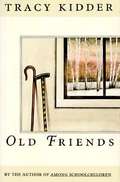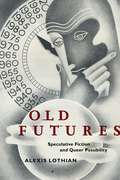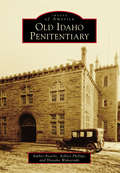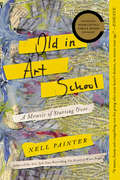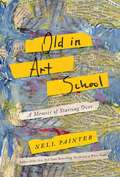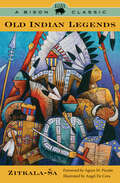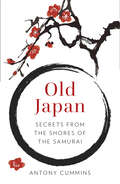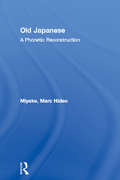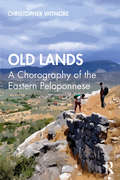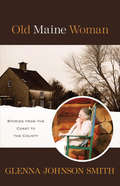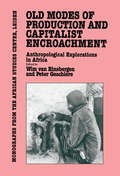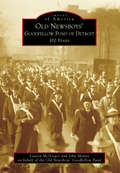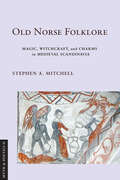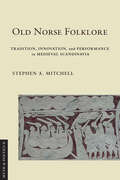- Table View
- List View
Old Age Homes (National Institute Social Services Library)
by Roger CloughOriginally published in 1981, in Old Age Homes Roger Clough presents a vivid description of the lives and work of residents and staff in an old people’s home. His powerful analysis of the realities of residential work would make a major contribution to improved practice, to social work training, and to social policy formation. Many people, including some social work professionals, still felt that the very existence of residential homes illustrated a failure of society, and that living with their own family or on their own was invariably a more satisfactory experience for old people. Roger Clough questions this assumption. He argues that homes are needed and if they are to be good places in which to live and die there must be a clearer understanding of the interactions that take place within them. The descriptive parts of the study, based on detailed observation and lengthy interviews, strongly reflect the author’s genuine compassion and warmth for old people. His most illuminating perceptions are presented from the perspective of the old people themselves, many of whom were conscious of the double-bind in which residents and staff are caught: there is a prevailing belief that it is best to keep active in old age, yet many of the elderly had little they though worth doing, while the staff saw their role as doing whatever they could for the residents. Roger Clough uses his material to test two central hypotheses: first that there is a linkage between the attitudes to aging held by staff and the degree of control over their own lives exercised by residents; and secondly that this degree of control is strongly correlated with resident satisfaction. Through an acute analysis of these key variables, he demonstrates the circumstances in which living in a home can be, for certain old people at certain times, the way of life they themselves would choose. His conclusions are of the greatest importance for social work practice and for the changing of staff attitudes in training. Old Age Homes would challenge anybody who knows or works with a resident in an old people’s home. But it would be of outstanding value for the managers, practitioners, trainers and students to whom it was primarily addressed at the time.
Old Age In Europe: A Textbook of Gerontology
by Marja Aartsen Kathrin KompEurope currently is the oldest continent in the world and its population is still ageing. This demographic shift affects society, economy, and welfare states. Scholars from various disciplines and the public noted this development and wonder what effects it may have, but lack adequate information. They call for explanations that are concise and easily accessible. The book at hand fills this lacuna. It introduces readers to the most important developments, theories, concepts, and discussions in ageing studies - always keeping an eye on the current situation in Europe. Each chapter adopts the perspective of a different discipline, e.g. public health, sociology, economics, or technology. To make the explanations easy to understand, the book includes learning tools such as learning objectives, multiple choice questions, and a glossary.
Old Age and Political Behavior: A Case Study
by Frank A. PinnerThis title is part of UC Press's Voices Revived program, which commemorates University of California Press’s mission to seek out and cultivate the brightest minds and give them voice, reach, and impact. Drawing on a backlist dating to 1893, Voices Revived makes high-quality, peer-reviewed scholarship accessible once again using print-on-demand technology. This title was originally published in 1959.
Old Age from Antiquity to Post-Modernity
by Paul Johnson Pat ThaneBased on themes such as status and welfare, Old Age from Antiquity to Post-Modernity examines the role of the elderly in history. This empirical study represents a substantial contribution to both the historical understanding of old age in past societies as well as the discussion of the contribution of post-modernism to historical scholarship.
Old Age in European Society: The Case of France (Routledge Library Editions: Aging)
by Peter N. StearnsOriginally published in 1977, Old Age in European Society provides an historical perspective on aging, a process which had received little attention from any group in the social sciences and virtually none from historians at the time. Starting from the premise that ‘the elderly can and should be active, participant members of their society’ the book examines the ways in which old people were and are viewed by certain key groups. This is done in a series of thematic essays linked by the main theme of a dominant culture in which the elderly and the groups who deal with them were and still are ensnared. This dominant culture is one of denigration of the elderly: the traditional idea of veneration of the elderly is found to be largely mythical. Variations on this theme are dealt with in individual chapters concerned with the elderly in French working-class culture and geriatric medicine. Key groups are studied with an eye to distinct patterns of modernization, which involves particular attention to the working class and middle class as those exposed to the leading edge of change. Women are treated separately, as their aging process involves distinctive elements, which exacerbate the problems of old age. France, with its exceptional percentage of elderly and its low retirement ages, provides much of the material for these essays, the main purpose of which is to indicate those topics for which an historical treatment is vital to our understanding of the elderly and to the formulation of a more positive approach to old age.
Old Age: Older Citizens And Political Processes In Britain (Key Ideas)
by John VincentRecent decades have seen a fundamental change in the age structure of many western societies. In these societies it is now common for a fifth to a quarter of the population to be retired, for fewer babies to be born than is required to sustain the size of the population and for life expectancy to exceed eighty years old. This book provides an overview of the key issues arising from this demographic change.
Old Beijing
by Susan Naquin Felicitas TitusCamel trains arriving at a city gate; the distinctive architecture of the Forbidden City, its pagodas, imperial buildings and temples; Manchu fashion, the Empress Dowager and the child emperor Puyi; street performers and foreign tourists-all come to life again in this extraordinary collection of rare and vintage postcards. Old Beijing: Postcards from the Imperial City offers a unique look at a vanished China and its storied capital. Comprising 350 black-and-white and hand-tinted cards that span the period from the last years of Imperial China to the Japanese invasion of 1937, it is a treasure trove for historians, collectors, Sinophiles, and anyone fascinated by people and cultures from times past.
Old Creole Days (Pelican Pouch)
by George CableThese stories reflect the Creole way of life during the transitory post-Civil War period.
Old English and the Theory of Phonology (Routledge Library Editions: Phonetics and Phonology #4)
by Bezalel E. DresherFirst published in 1985. This title is a study in the synchronic and diachronic phonology and morphology of the Mercian dialect of Old English. It is particularly concerned with issues in the theory of phonology that have been the subject of the ‘abstractness controversy’, which developed in response to the theory of phonology put forward by Chomsky and Hale. This title will be of interest to students of English language and linguistics.
Old Fields: Photography, Glamour, and Fantasy Landscape
by John R. StilgoeGlamour subverts convention. Models, images, and even landscapes can skew ordinary ways of seeing when viewed through the lens of photography, suggesting new worlds imbued with fantasy, mystery, sexuality, and tension.In Old Fields, John Stilgoe—one of the most original observers of his time—offers a poetic and controversial exploration of the generations-long effort to portray glamour. Fusing three forces in contemporary American culture—amateur photography after 1880; the rise of glamour and fantasy; and the often-mysterious quality of landscape photographs—Stilgoe provides a wide-ranging yet concentrated take on the cultural legacy of our photographic history.Through the medium of "shop theory"—the techniques, tools, and purpose-made equipment a maker uses to realize intent—Stilgoe looks at the role of Eastman Kodak in shaping the ways photographers purchased cameras and films, while also mapping the divisions that were created by European-made cameras. He then goes on to argue that with the proliferation of digital cameras, smart phones, and Instagram, young people’s lack of knowledge about photographic technique is in direct correlation to their lack of knowledge of the history of glamour photography.In his exploration of the rise of glamour and fantasy in contemporary American culture, Stilgoe offers a provocative and very personal look into his enduring fascination with, and the possibilities inherent in, creating one’s own images.
Old Forts of the Northwest
by Herbert M. Hart Paul J. HartleBeyond the wide Missouri lay the prairie—“the biggest clearing on the Almighty’s footstool.” And every few hundred miles, holding to the rivers and wooded bottoms, were the outposts of the white civilization—the military forts of the U.S. Army. Father, mother and comforter to the settlers, trading points for the trappers and buffalo hunters, rallying points for the scouts.Awaiting the reader of this sentimental journey into the days of “Boots and Saddles,” are the graphic stories of battles against Indians and boredom. A military man, author Hart has the feel of these men who did the fighting and their places of conflict and refuge. He recounts the Bloody Bozeman outrage, Red Cloud’s War of 1866-68, and the pre-Civil War fights that seasoned lieutenants for the stars of Union and Confederate generals.It is a thrilling experience to read of the forts that opened the West for the stages, river boats and wagon trains...of those that protected the white man from the Indians and others that protected Indians from the whites...of those “hog and hominy” forts that gave solace to settlers who waited for the Indian attacks that never came...of the places called “Hog Ranches” that provided soldiers with entertainment lacking at Army posts...and of those forts George Armstrong Custer called home.With all this there are portraits, in both word and photograph, of the many famous generals who rode this frontier of history: Sherman, Sheridan, Crook, Custer, Harney, Sully, Connor, Mackenzie, Howard, Miles, Terry, Carrington, de Trobriand, Gibbon and Canby.
Old Friends
by Tracy KidderTracy Kidder has turned his talents to his most important and universal theme in this, a close-in study of old age in America. With care and exactitude, with the human compassion and humor for which he is famed, Kidder opens up a fascinating world to us that is, at the same time, foreign and compelling. The narrative takes place entirely in a nursing home and focuses on two old men struggling with their circumstances, their memories, and their mortality.
Old Futures: Speculative Fiction and Queer Possibility (Postmillennial Pop #10)
by Alexis LothianFinalist, 2019 Locus Award for Nonfiction, presented by the Locus Science Fiction FoundationTraverses the history of imagined futures from the 1890s to the 2010s, interweaving speculative visions of gender, race, and sexuality from literature, film, and digital mediaOld Futures explores the social, political, and cultural forces feminists, queer people, and people of color invoke when they dream up alternative futures as a way to imagine transforming the present. Lothian shows how queer possibilities emerge when we practice the art of speculation: of imagining things otherwise than they are and creating stories from that impulse. Queer theory offers creative ways to think about time, breaking with straight and narrow paths toward the future laid out for the reproductive family, the law-abiding citizen, and the believer in markets. Yet so far it has rarely considered the possibility that, instead of a queer present reshaping the ways we relate to past and future, the futures imagined in the past can lead us to queer the present. Narratives of possible futures provide frameworks through which we understand our present, but the discourse of “the” future has never been a singular one. Imagined futures have often been central to the creation and maintenance of imperial domination and technological modernity; Old Futures offers a counterhistory of works that have sought—with varying degrees of success—to speculate otherwise. Examining speculative texts from the 1890s to the 2010s, from Samuel R. Delany to Sense8, Lothian considers the ways in which early feminist utopias and dystopias, Afrofuturist fiction, and queer science fiction media have insisted that the future can and must deviate from dominant narratives of global annihilation or highly restrictive hopes for redemption.Each chapter chronicles some of the means by which the production and destruction of futures both real and imagined takes place: through eugenics, utopia, empire, fascism, dystopia, race, capitalism, femininity, masculinity, and many kinds of queerness, reproduction, and sex. Gathering stories of and by populations who have been marked as futureless or left out by dominant imaginaries, Lothian offers new insights into what we can learn from efforts to imaginatively redistribute the future.
Old Idaho Penitentiary
by Hanako Wakatsuki Amber Beierle Ashley PhillipsBetween 1872 and 1973, the Idaho State Penitentiary housed over 13,000 inmates. Some of Idaho's most corrupt and cunning criminals resided behind these Boise sandstone walls. Constructed in large part by inmate labor, the "Old Idaho Penitentiary" stands as a reminder of Idaho's Wild West past. Horse thieves, moonshiners, bank robbers, and assassins alike all called this penitentiary home. Owned and operated by the Idaho State Historical Society, the Old Idaho Penitentiary is one of only four territorial prisons open to the public in the United States.
Old In Art School: A Memoir of Starting Over
by Nell Irvin PainterA finalist for the National Book Critics Circle Award, this memoir of one woman's later in life career change is “a smart, funny and compelling case for going after your heart's desires, no matter your age” (Essence).Following her retirement from Princeton University, celebrated historian Dr. Nell Irvin Painter surprised everyone in her life by returning to school––in her sixties––to earn a BFA and MFA in painting. In Old in Art School, she travels from her beloved Newark to the prestigious Rhode Island School of Design; finds meaning in the artists she loves, even as she comes to understand how they may be undervalued; and struggles with the unstable balance between the pursuit of art and the inevitable, sometimes painful demands of a life fully lived.How are women and artists seen and judged by their age, looks, and race? What does it mean when someone says, “You will never be an artist”? Who defines what an artist is and all that goes with such an identity, and how are these ideas tied to our shared conceptions of beauty, value, and difference?Bringing to bear incisive insights from two careers, Painter weaves a frank, funny, and often surprising tale of her move from academia to art in this "glorious achievement––bighearted and critical, insightful and entertaining. This book is a cup of courage for everyone who wants to change their lives" (Tayari Jones, author of An American Marriage).
Old In Art School: A Memoir of Starting Over
by Nell PainterFollowing her retirement from Princeton University, celebrated historian Dr. Nell Irvin Painter surprised everyone in her life by returning to school--in her sixties--to earn a BFA and MFA in painting. In Old in Art School, she travels from her beloved Newark to the prestigious Rhode Island School of Design; finds meaning in the artists she loves, even as she comes to understand how they may be undervalued; and struggles with the unstable balance between the pursuit of art and the inevitable, sometimes painful demands of a life fully lived. How are women and artists seen and judged by their age, looks, and race? What does it mean when someone says, "You will never be an artist"? Who defines what "An Artist" is and all that goes with such an identity, and how are these ideas tied to our shared conceptions of beauty, value, and difference? Old in Art School is Nell Painter's ongoing exploration of those crucial questions. Bringing to bear incisive insights from two careers, Painter weaves a frank, funny, and often surprising tale of her move from academia to art.
Old Indian Legends
by Zitkala-SaEarly in the century a magnificent Sioux woman named Zitkala-Ša published these legends that she learned during her childhood on the Yankton Reservation. Her eastern education developed a writing talent that was put to good use in recording from oral tradition the exploits of Iktomi the trickster, Eya the glutton, the Dragon Fly, the Blood Clot boy, and other magical and mysterious figures, human and animal, known to the Sioux. Until her death in 1938, Zitkala-Ša stood between two cultures as preserver and translator.
Old Japan: Secrets from the Shores of the Samurai
by Antony CumminsJapan has often been thought of as a closed country, but before the country was closed in 1635 many travellers from the West were able to experience its unique traditions and culture. Their accounts speak of legends of powerful dragons and devils, tales of the revered emperor and the protocol surrounding him, following complex etiquette in everything from tea ceremonies to footwear, and bloodthirsty warlords who exacted cruel and unusual punishments for the smallest of crimes. In Old Japan Antony Cummins uses these captivating eyewitness accounts to reveal fascinating facts and myths from the mysterious Land of the Rising Sun.
Old Japanese: A Phonetic Reconstruction
by Marc Hideo MiyakeWhat did eighth-century Japanese sound like? How does one decode its complex script? This book provides the definitive answers to these questions using an unprecedented range of data from the past and the present.
Old Lands: A Chorography of the Eastern Peloponnese
by Christopher WitmoreOld Lands takes readers on an epic journey through the legion spaces and times of the Eastern Peloponnese, trailing in the footsteps of a Roman periegete, an Ottoman traveler, antiquarians, and anonymous agrarians. Following waters in search of rest through the lens of Lucretian poetics, Christopher Witmore reconstitutes an untimely mode of ambulatory writing, chorography, mindful of the challenges we all face in these precarious times. Turning on pressing concerns that arise out of object-oriented encounters, Old Lands ponders the disappearance of an agrarian world rooted in the Neolithic, the transition to urban-styles of living, and changes in communication, movement, and metabolism, while opening fresh perspectives on long-term inhabitation, changing mobilities, and appropriation through pollution. Carefully composed with those objects encountered along its varied paths, this book offers an original and wonderous account of a region in twenty-seven segments, and fulfills a longstanding ambition within archaeology to generate a polychronic narrative that stands as a complement and alternative to diachronic history. Old Lands will be of interest to historians, archaeologists, anthropologists, and scholars of the Eastern Peloponnese. Those interested in the long-term changes in society, technology, and culture in this region will find this book captivating.
Old Maine Woman: Stories from The Coast to The County
by Glenna Johnson SmithGlenna Johnson Smith writes with eloquence and humor about the complexities, absurdities, and pleasures of the every day, from her nostalgic looks at her childhood on the Maine coast in the 1920s and 1930s, to her observations of life under the big sky and among the rolling potato fields of her beloved Aroostook County, where she has lived for nearly seven decades. The book also includes some of her best fiction pieces.
Old Modes Of Production & Capital In Africa
by VanFirst published in 1985. Routledge is an imprint of Taylor & Francis, an informa company.
Old Newsboys' Goodfellow Fund of Detroit: 100 Years (Images of America)
by John Minnis Old Newsboys' Goodfellow Fund Lauren McgregorIt started with a cartoon--"Forgotten," by Tom May--in which a poor child, too young and innocent to understand why she had not received a Christmas present from Santa, weeps over an empty stocking. It ran on Christmas Day in 1908 in the Detroit Journal, where it caught the attention of key Detroit businessmen. Deeply moved, they entered into a solemn pact to do all within their power to prevent any Detroit child from being "forgotten." In 1914, under the leadership of James J. Brady, himself a former newsboy, the Old Newsboys' Goodfellow Fund of Detroit was formed. This year, the fund celebrates 100 years of making sure there is "no kiddie without a Christmas." One such fortunate kiddie was retired Detroit News columnist Pete Waldmeir, a longtime Goodfellow who generously agreed to write the introduction to this book, Old Newsboys' Goodfellow Fund of Detroit: 100 Years.
Old Norse Folklore: Magic, Witchcraft, and Charms in Medieval Scandinavia (Myth and Poetics II)
by Stephen A. MitchellThe second volume of Old Norse Folklore explores medieval and early modern Nordic magic and witchcraft, covering syncretism, continuity, survival, and the reconstruction of pagan beliefs and cultic practices in this last area of western Europe to be Christianized. This volume not only considers these issues but also pulls back the curtain on more obscure, yet important, corners of Nordic magico-religious tradition.In these chapters, Stephen A. Mitchell draws on materials from many different periods of the vast Nordic world, stretching from Greenland to the Baltic, and examines such diverse witnesses as sagas, judicial records, ballads, synodal statutes, runes, proverbs, church murals, leechbooks, and the language used to discuss magic and its actors. Old Norse Folklore addresses how theology helped to shape the Nordic magical world and how language can reveal this world, how magic was used as a practical matter in (and what it meant philosophically to) the medieval Nordic world, and how inherited traditions between and among the historically connected societies of northern Europe impacted cultural developments in late medieval Scandinavia.
Old Norse Folklore: Tradition, Innovation, and Performance in Medieval Scandinavia (Myth and Poetics II)
by Stephen A. MitchellThe medieval northern world consisted of a vast and culturally diverse region both geographically, from roughly Greenland to Novgorod and culturally, as one of the last areas of Europe to be converted to Christianity. Old Norse Folklore explores the complexities of this fascinating world in case studies and theoretical essays that connect orality and performance theory to memory studies, and myths relating to pre-Christian Nordic religion to innovations within late medieval pilgrimage song culture.Old Norse Folklore provides critical new perspectives on the Old Norse world, some of which appear in this volume for the first time in English. Stephen A. Mitchell presents emerging methodologies by analyzing Old Norse materials to offer a better understandings ofunderstanding of Old Norse materials. He examines, interprets, and re-interprets the medieval data bequeathed to us by posterity—myths, legends, riddles, charms, court culture, conversion narratives, landscapes, and mindscapes—targeting largely overlooked, yet important sources of cultural insights.

